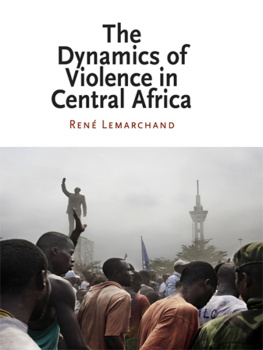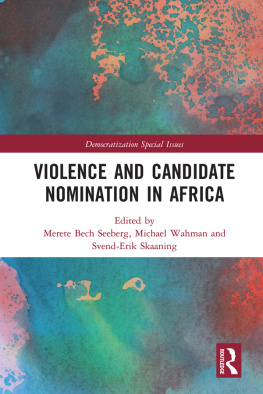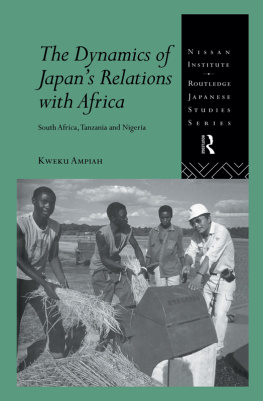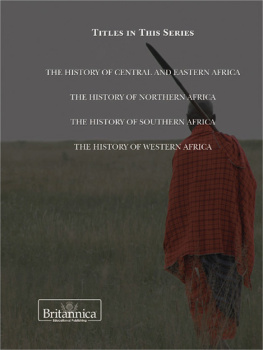Lemarchand - The Dynamics of Violence in Central Africa
Here you can read online Lemarchand - The Dynamics of Violence in Central Africa full text of the book (entire story) in english for free. Download pdf and epub, get meaning, cover and reviews about this ebook. City: Philadelphia, year: 2009, publisher: Lightning Source Inc.;University of Pennsylvania Press, genre: Politics. Description of the work, (preface) as well as reviews are available. Best literature library LitArk.com created for fans of good reading and offers a wide selection of genres:
Romance novel
Science fiction
Adventure
Detective
Science
History
Home and family
Prose
Art
Politics
Computer
Non-fiction
Religion
Business
Children
Humor
Choose a favorite category and find really read worthwhile books. Enjoy immersion in the world of imagination, feel the emotions of the characters or learn something new for yourself, make an fascinating discovery.
- Book:The Dynamics of Violence in Central Africa
- Author:
- Publisher:Lightning Source Inc.;University of Pennsylvania Press
- Genre:
- Year:2009
- City:Philadelphia
- Rating:4 / 5
- Favourites:Add to favourites
- Your mark:
- 80
- 1
- 2
- 3
- 4
- 5
The Dynamics of Violence in Central Africa: summary, description and annotation
We offer to read an annotation, description, summary or preface (depends on what the author of the book "The Dynamics of Violence in Central Africa" wrote himself). If you haven't found the necessary information about the book — write in the comments, we will try to find it.
The Dynamics of Violence in Central Africa — read online for free the complete book (whole text) full work
Below is the text of the book, divided by pages. System saving the place of the last page read, allows you to conveniently read the book "The Dynamics of Violence in Central Africa" online for free, without having to search again every time where you left off. Put a bookmark, and you can go to the page where you finished reading at any time.
Font size:
Interval:
Bookmark:
Acknowledgments
My immediate purpose in putting together this volume is to make readily accessible to interested scholars a selection of my recent (and not so recent) writing on former Belgian Africa. Although most of these appeared in professional journals and edited volumes, none was a source of high visibility. The themes explored in this book have incubated in a wonderfully stimulating and diverse academic environment. Following my long-awaited retirement from the University of Florida, and from the time I left USAID in 1998, after four years in Abidjan and two in Accra as Regional Advisor for Democracy and Governance, I had the opportunity to serve as visiting lecturer at Berkeley, Smith College, Concordia (Montreal), and Brown and subsequently at the universities of Bordeaux, Antwerp, Copenhagen, and Helsinki. My post-retirement gypsy-scholar career has given me plenty of occasions to bounce ideas off an array of students, colleagues, and USAID officials, who to one degree or another shared my interest in the tragic destinies of the Great Lakes region of Central Africa. Their contributions are reflected in many of the essays in this volume.
I have many people to thank, first and foremost, the students in my graduate seminars at the universities of California at Berkeley, Antwerp, and Copenhagen. Many have gently provoked me into rethinking some of the ideas developed in this book. I owe a special debt to Filip Reynt-jens, my long-time friend and colleague at the University of Antwerp, whose knowledge of the politics of the Great Lakes is unsurpassed, and to Holger Hansen, Chair of the African Studies Center at the University of Copenhagen, for repeatedly inviting me to teach and lecture on Central Africa. My long-time friend and colleague Frank Chalk deserves equal thanks for iniviting me to teach at Concordia University (Montreal) in the fall of 2000. Special mention is owed to Danielle De Lame, for sharing with me her wide-ranging expertise on Rwanda, and to David and Catharine Newbury for keeping me abreast of their pioneering work 326 Acknowledgments on the Great Lakes and their continuing support in my efforts to challenge received ideas about the history and politics of the region. No words can properly acknowledge my indebtedness to Jan Vansina: our many phone conversations on Rwanda's complicated past have provided me with powerful adrenalin boosts when I needed them most. I am also grateful to Koen Vlassenroot, of the University of Ghent, for his patience and unfailing assistance in sharing with me his meticulous knowledge of Mai-Mai politics in eastern Congo. And I much appreciate the judicious advice proffered by Crawford Young and David Newbury while putting the finishing touch to the manuscript.
Thanks are due as well to my African friends and graduate students who, sometimes literally, went out of their way to educate me on the past and recent history of the region. Among the many names that spring to mind, those of Maurice Niwese, Deo Niyonzima, Willy Nindorera, JeanMarie Ngendahayo, Severin Mugangu, Bucyalimwe Mararo, Emmanuel Lubala, Bosco Mushikwa, Antoine Ghonda Mangalibi, Pierre Nzok-izwanimana, Roger Bashali, and Roger Kasereka deserve special mention. None of them, to use the ritual phrase, are responsible for any errors of fact and interpretation that the reader may detect. I also owe a special debt of gratitude to Ashley Leinweber for helping me navigate the treacherous waters of electronic files when the time came to submit the manuscript to the editor.
I also wish to extend my appreciation to the editors and publishers of the following books and journals for permission to reprintwith only minor alterations in the text and titlesthe materials appearing in this volume: (The Tunnel at the End of the Light), Review of Political Economy, nos. 9394 (2002): 38998.
Contributions not previously published include Chapters (From Kabila to Kabila: What Else Is New?). The first was presented in Copenhagen in 2002 at a conference on the Rwanda genocide organized by the Danish Center for Holocaust and Genocide Studies. The second was prepared for the 2006 colloquium Opting for Genocide, organized by Andreas Mehler and cosponsored by the Hamburg Institute of Social Research and the Institute of African Affairs of the University of Hamburg. The third is from a lengthier report commissioned in 1993 while I served as USAID Regional Adviser on Governance and Democracy for West Africa, in Abidjan. The fourth is a communication written for the conference Social Capital in Eastern Congo, organized at the University of Antwerp, in 2001. The final chapter was specifically written for this volume following the 2006 elections in the DRC.
Chapter 1
The Geopolitics of the Great Lakes Region
In common usage the Great Lakes region refers to Central Africa's Great Rift valley, stretching on a north-south axis along the Congo-Nile crest, from Lake Tanganyika in the south to Lake Edward and the legendary Mountains of the Moon in the north. But where exactly does it begin, and where does it end? Should it include western Tanzania and southwestern Sudan? Should the Maniema and north Katanga be factored in as well? The answers are anything but straightforward. There is general agreement, however, that a minimal definition should include Rwanda, Burundi, eastern Congo, and southwestern Uganda as the core area of what once was called the interlacustrine zone of the continent, covering an estimated 300,000 square miles. This is the sense in which we shall use the phrase.
The interlacustrine metaphor, though still fashionable among geographers, suggests too much in the way of uniformity and too little about the diversity of peoples, cultures, and subregions subsumed under this label. Since these words were written (1986), most of these encounters have been extremely bloody and their after-effects, devastating.
At the root of these confrontations lies an array of forces and circumstances of enormous complexity. Most are the product of human decisions made during the colonial and postcolonial eras, but these must be seen in the perspective of the drastic changes that have taken place in the regional environment. Politics and geography intersect in different ways at different points in time, but the key variables remain the same. The potential for conflict is inscribed in the discontinuities in population densities, the availability of land, the cultural fault lines discernible in different language patterns, modes of social organization, and ecological circumstances. None of the above were fixed from time immemorial. As has been noted time and again, most recently by Michael Mann, modernity has gone hand in hand with eruptions of ethnic violence. today's Great Lakes region shows many of the symptoms of a Hobbesian universe.
Convenient though it is to speak of the crisis in the Great Lakes in the singular, it makes more sense to think in terms of a multiplicity of crises, which, though historically distinct and occurring in specific national contexts, have set off violent chain reactions in neighboring states. The Hutu revolution (195962) in Rwanda was one such crisis. Another was the 1994 genocide. Both have sent shock waves through the region the first creating the conditions of a partial genocide of Hutu in Burundi in 1972, the second unleashing ethnic cleansing, population displacements, and civil war through many parts of the Congo, resulting in human losses far greater than in either Burundi in 1972 or Rwanda in 1994. To these we shall return in a moment, but before going any further, a note of caution is in order about some of the misconceptions surrounding the region's recent agonies.
Challenging Received Ideas
The belief that nowhere in the continent has violence taken a heavier toll than in Rwanda, with nearly a million deaths, overwhelmingly Tutsi, is one of the most persistent and persistently misleading ideas about the region. It may come as a surprise, therefore, that four times as many people have died in eastern Congo between 1998 and 2006. Although the exact number will never be known, a recent survey by the International Rescue Committee (IRC) shows that nearly four million people were killed from war-related causes in the Democratic Republic of the Congo (DRC) since 1998, the largest documented death toll in a conflict since World War II.
Next pageFont size:
Interval:
Bookmark:
Similar books «The Dynamics of Violence in Central Africa»
Look at similar books to The Dynamics of Violence in Central Africa. We have selected literature similar in name and meaning in the hope of providing readers with more options to find new, interesting, not yet read works.
Discussion, reviews of the book The Dynamics of Violence in Central Africa and just readers' own opinions. Leave your comments, write what you think about the work, its meaning or the main characters. Specify what exactly you liked and what you didn't like, and why you think so.








